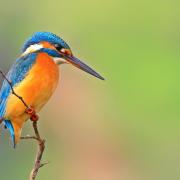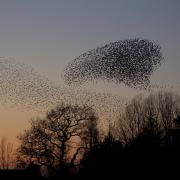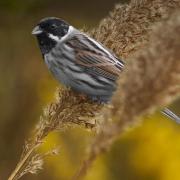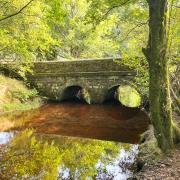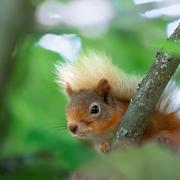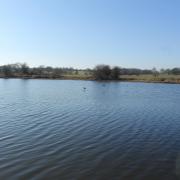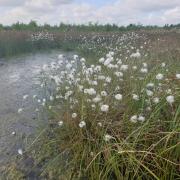Six of the best locations to spot rare species are on our doorsteps thanks to the Wildlife Trust. Alan Wright reports
Wildlife in Lancashire is not shy at any time of the year but summer is when it is keen to display its true colours. And the colours of summer appear brighter on the reserves of the Wildlife Trust for Lancashire, Manchester and North Merseyside where a great deal has been done over winter and spring by staff and volunteers to improve habitats.
The trust owns more than 30 nature reserves in every corner of the region and manages many more. Lancashire Life asked reserve officers to choose the top reserves to visit this summer.
1 Brockholes An extensive network of footpaths has been installed to offer walks to suit everyone. Reserve manager Sophie Leadsom says: ‘Some paths will lead you through the largest, single tract of semi-natural ancient woodland in Lancashire surrounded by traditional woodland flowers. This amazing floral display is set against the sounds of song thrush, blackcap, garden warbler, chiffchaff, nuthatch and robin declaring their breeding territories among the mature trees. Roe deer, foxes or stoats may be glimpsed through the trees.
‘Other footpaths wind you through the nature reserve taking you through the wild flower meadows past bird’s foot trefoils, vetchlings, woundworts and buttercups, or along the River Ribble where kingfishers and banded demoiselles can be found close to the breeding sand martin colony.’ Brockholes is signposted off junction 31 of the M6.
2 Wigan Flashes Project manager Mark Champion is rightly proud of the work to restore areas of mining subsidence. ‘You can see Cetti’s warbler in the willows. This rare bird is moving north due to the current climate change and has just reached Wigan,’ he says. The bitterns did not breed, although they are seen regularly.’
Water voles can also be seen in the ditches and swimming between the reedbeds. Look out for the little silver torpedoes that are water shrews. ‘This is one of the north west’s most important sites for dragonflies with 22 species recorded. The butterflies are impressive too and records include large skipper and white letter hairstreak,’ saays Mark. The Wigan Flashes entrance is at Welham Road, WN3 5NY.
3 Mere Sands WoodLindsay Beaton, reserve manager for 100 acres of this woodland, grassland and lakes on the agricultural plain of West Lancashire, says: ‘Summer migrants such as chiffchaff and reed warbler join the resident tree sparrows, bullfinches, tawny owls and other species to breed here. In summer there are dragonflies and damselflies in abundance, with the site noted as being nationally important for these species.
‘The Meadow is an example of the traditional rush pasture that would have been found in this area before the draining of the land - flower-rich and with butterflies, moths and other insects. Roe Deer and red squirrels can be spotted in the woods.’ The reserve is easily accessible with firm level paths and six bird viewing hides and a visitor centre (open every day except Friday. Mere Sands Wood is off Holmeswood Road in Rufford, L40 1TG.
4 Freshfield Dune Heath A former golf course and army base, Freshfield is testament to the work of former conservation officer for Merseyside ,Steve White, his successor, Fiona Whitfield, and their team.
Freshfield’s 17 hectares of dune heath comprise nine per cent of the national total of this rare habitat. Heather, sand sedge, wavy hair-grass and sheep’s fescue are the dominant vegetation but a number of other specialist plants occur.
This is a wonderful habitat for insects including some spectacular beetles and moths, northern dune tiger beetle and goat moth. Freshfields attracts species of warblers including rarities like Sardinian warbler, barred warbler and firecrest.
But the heath is perhaps best known for common and sand lizards seen basking on the dunes. Red squirrels have been sighted in local woodland linking up to other colonies along the coast. It is behind Freshfield Railway Station in Formby L37 7DD.
5 Salthill QuarryThis was a working quarry until 1959, producing limestone for industrial and agricultural use. Now it has been transformed, thanks to East Lancs reserves officer, Phil Dykes, and his volunteers into a nature reserve important for its geology as well as its wildlife.
‘Taking a walk round the reserve will reveal plenty of fossils and rock features, but will also give the opportunity to spot plenty of wildlife,’ says Phil. ‘Common blue butterflies like the meadow areas, as do others such as meadow brown and red admiral. Goldfinches and bullfinches are also usually in evidence. In July the purple flowering Betony dominates the main meadow. The three varieties of scabious are all found in flower.
‘The summer visitors include blackcap, willow warbler, garden warbler and chiffchaff. Lesser whitethroat has also been regularly present in recent years. As evening develops tawny owls can often be heard and pipistrelle bats will be hunting for small insects.’ Salthill Quarry is north east of Clitheroe on Lincoln Way, BB7 1QL.
6 Warton CragWarton Crag’s mix of woodland, wetland and limestone make it one of Britain’s best areas for butterflies. Rare species like the the pearl bordered fritillary, the high brown fritillary and the northern brown argus are seen among the plants here. There are also important moths.
LWT northern reserves worker Steve Ryder says: ‘Now a rare butterfly, the pearl bordered fritillary colonies survive only where conservation management provides the right woodland conditions.’
Warton Crag is a mile north of Carnforth and close to the village of Warton LA5 9RY.











